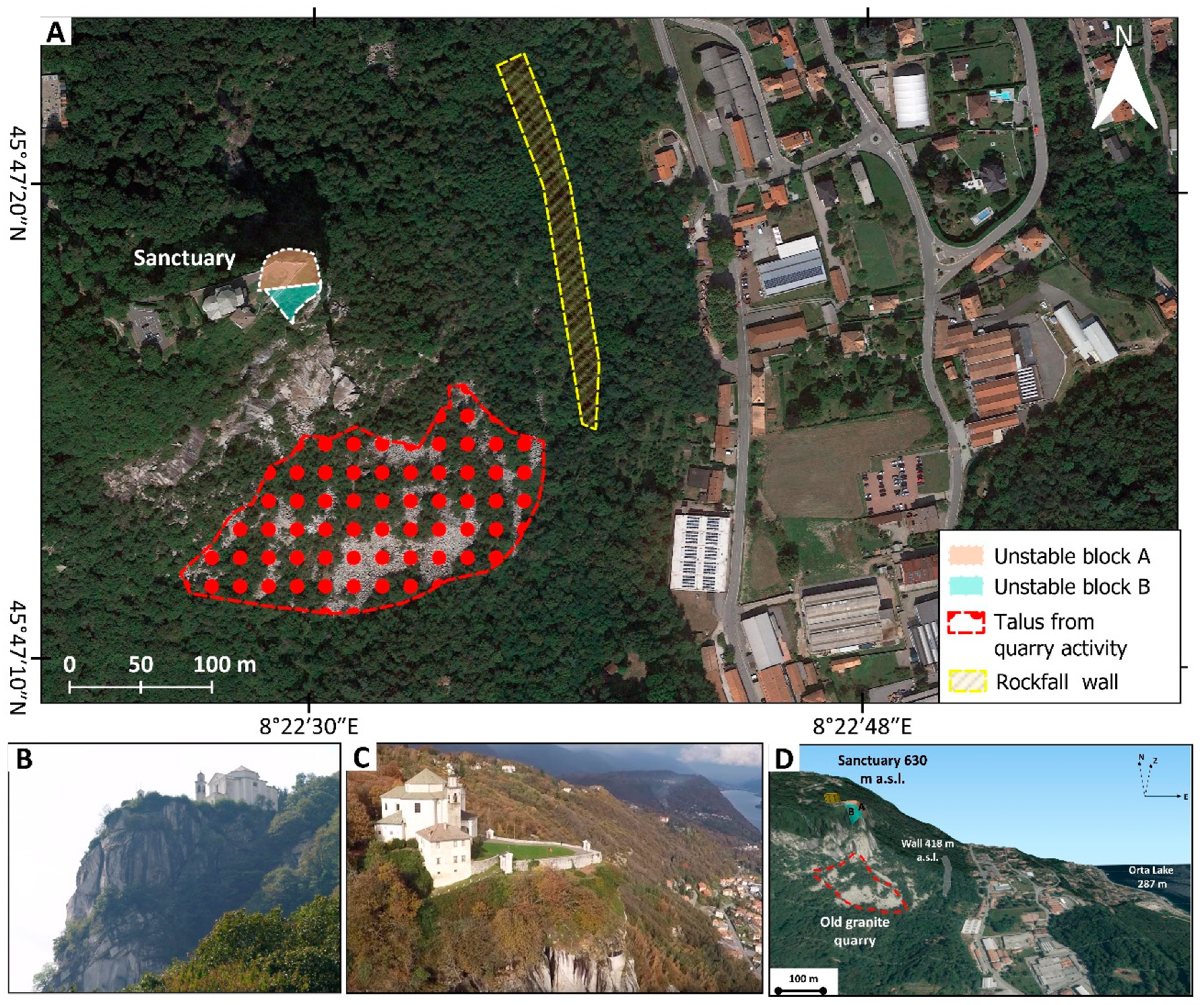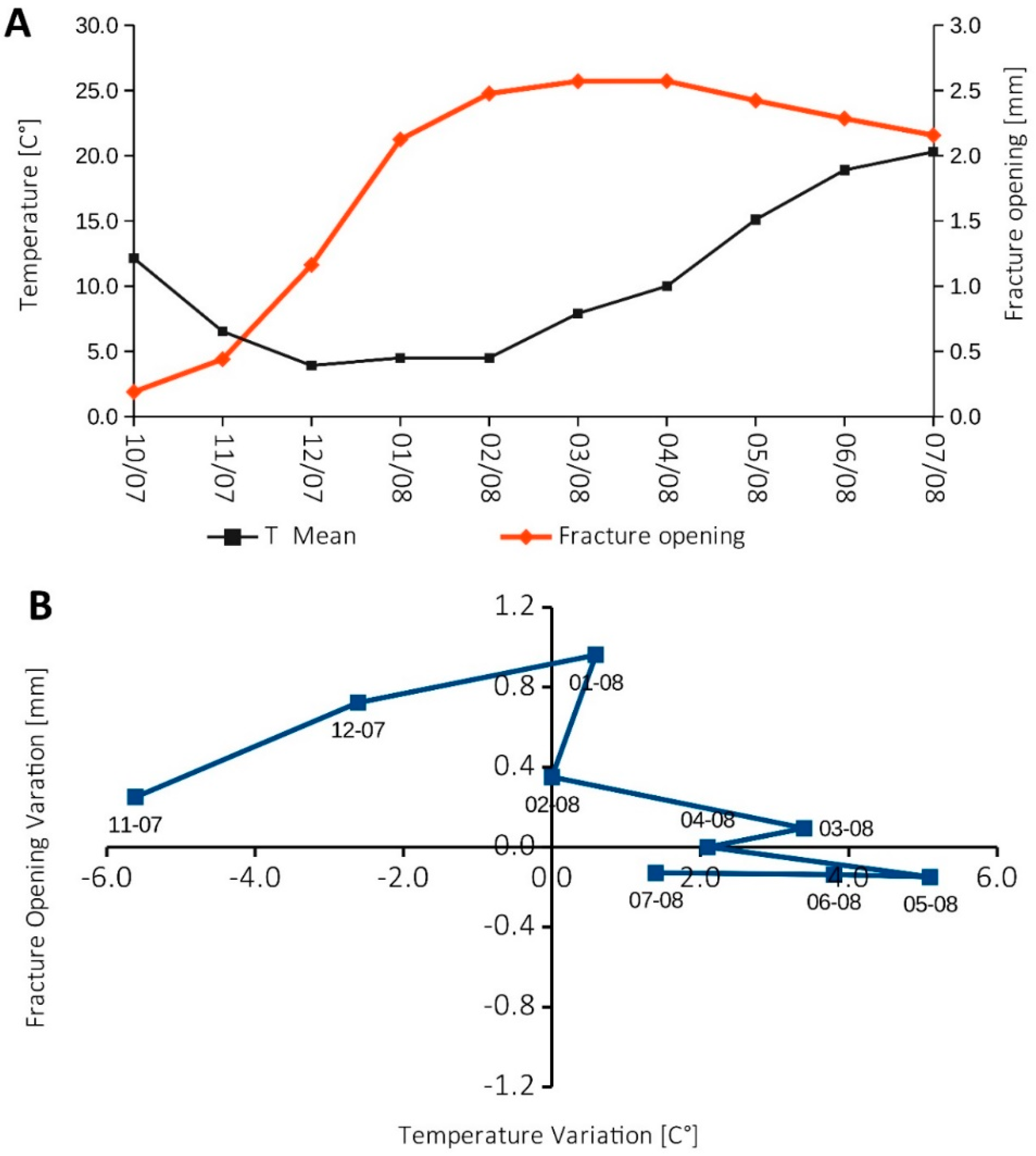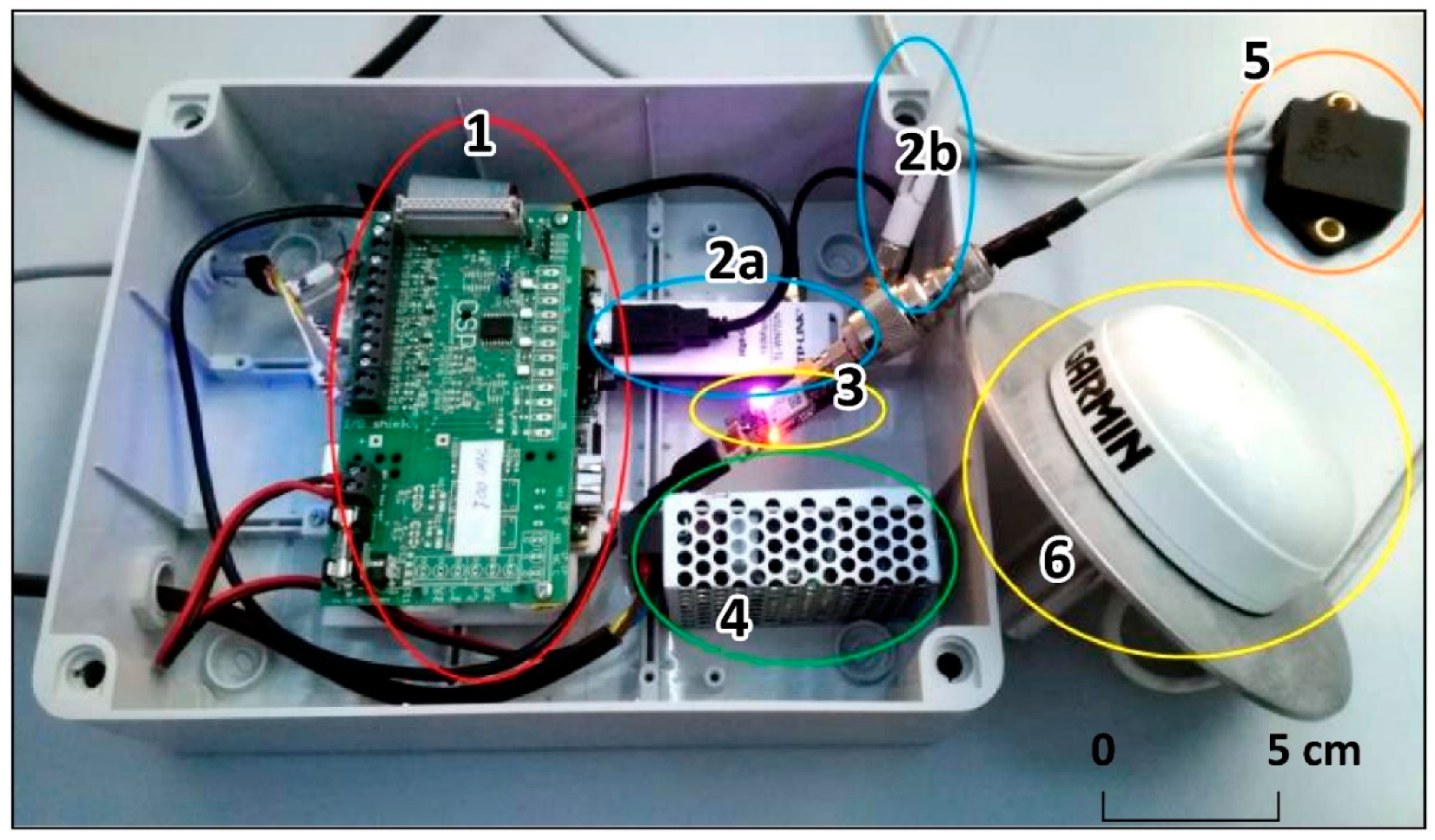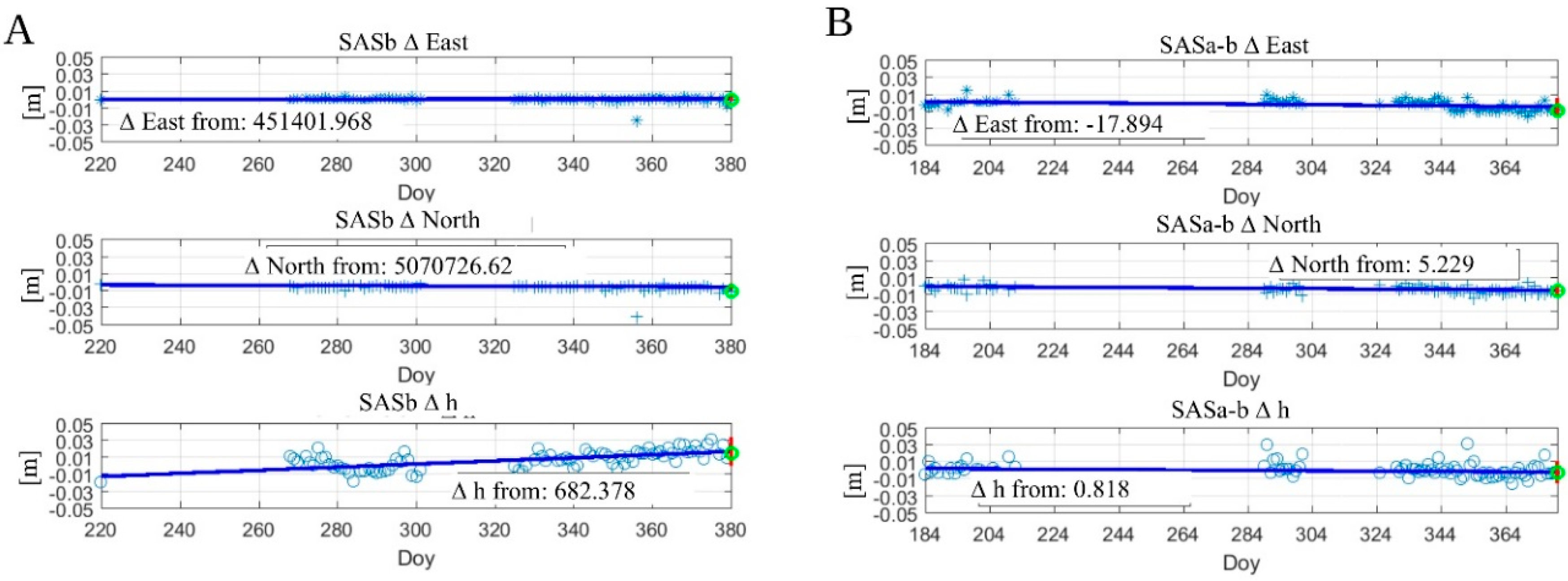Low-Cost GNSS Solution for Continuous Monitoring of Slope Instabilities Applied to Madonna Del Sasso Sanctuary (NW Italy)
Abstract
1. Introduction
2. Study Area and Past Monitoring Analysis
2.1. Geological Framework
2.2. Structural and Geomechanical Characterization
2.3. Unstable Slope Behavior
- The observation of a seasonal cycle of thermal expansion of the rock mass. This interesting behavior was detected by combining MS investigation, topographic monitoring, and wire-strain gauge measurements. The MS rate was coherently recognized to be mainly driven by temperature. The maximum frequency of events occurred during summer, with thermal expansion, while a minimum of the MS events was recorded in winter months when the fractures are opening due to contraction on the bedrock.
- The MS investigation pointed out the presence of many MS events, which are related to rapid air temperature variations (temporal gradient), or marked temperature differences between the cliff’s faces (spatial gradient). These events could cause differential thermal dilation and induce thermal stresses leading to microcracking processes within the cliff, as already demonstrated by [28].
- The temperature control was found to be the cause not only of fracture opening/closing with a seasonal frequency, but also for a general change in the vibration directions measured during MS investigations of the two unstable blocks. In addition, the daily cycle of thermal variation influences unstable blocks behavior as observed on seismic noise resonance [22].
- The observation of a long-term trend in which block “A” tends to slide towards NE of 2/3 mm per year. This trend is probably related to progressive weakness and degradation of rock bridges in fractures caused by the expansion–contraction cycle.
3. Materials and Methods
- The production of an operative monography (OM). In this project, we decided to adopt the OM approach [23] for the acquisition and organization of all available information (e.g., monitoring data, thematic studies, publications, and maps). The first step of the project has been the collection, analysis, and organization of the available material. This approach is particularly useful when the analyzed site has a long history of studies, in situ exploration, and monitoring that could have produced a large amount of data that is not always well organized. The OM has been very useful for the definition of what has been already defined by the previous study. Thus, we used the collected literature data for the identification of better positions for GNSS installation.
- The re-analysis of ARPA-Piemonte topographic network data. The topographic dataset acquired by ARPA Piemonte is available from 2006, and it represents the most important source of information for the definition of displacement trends. In the re-analysis, we removed some outlier measurements, and we recalculate linear regression of displacement time series (horizontal and 3D). This helped the comparison with other monitoring instruments like the PS InSAR and the new GNSS data.
- Design, implementation, and test of GNSS low-cost sensors. The GNSS system has been developed and tested in the laboratory. After these first phases, the system has been installed in the unstable area, and it becomes the first in place continuous topographic monitoring solution adopted for the study of the evolution of the Madonna del Sasso cliff. Two low-cost GNSS sensors were installed on-site to measure the position of two different representative points continuously. The adopted monitoring network is equipped with hardware and software solutions that guarantee not only the in-situ acquisition but also the raw data transmission and processing.
- Definition of a semi-automatic early warning (EW) procedure. The final step of the project has been the development of a GNSS results analysis aimed to implement an early warning (EW) procedure. The EW procedure is a step-by-step methodology that has the aim to firstly define critical alert thresholds indicative of a possible increase of blocks instability. After validation, the alert could be used to issue a bulletin for risk communications [29].
3.1. The Operative Monography (OM)
3.2. Available Topographic Monitoring: Data Analysis
3.3. Design, Implementation, and Installation of a Low-Cost GNSS Monitoring System
3.3.1. Hardware Technology Installed and Calibration
- A micro PC with a Linux operating system that controls all the sensors. It is equipped with a mainboard (1 in Figure 6), four powered USB interfaces, a removable memory card on which the operating system and data are stored. The micro PC is programmable by remote control like (e.g., via Dongle Wi-Fi, 2a and 2b in Figure 6) by any Linux computer. The micro PC also manages the dialogue with the uBlox receiver (3 in Figure 6), with the accelerometer and the temperature sensor. The system must be externally powered either by a power supply (4 in Figure 6) or by a solar panel. The micro PC also manages the transmission of data to the control center, both the accelerometric (5 in Figure 6) and temperature data and the corrections in the Radio Technical Commission for Maritime Services (RTCM) format of the GNSS sensor.
- uBlox EVK8T GNSS receiver (3 in Figure 6). It provides data on the first frequency of the three GNSS constellations: GPS, Galileo and Beidou. However, during the months in which the receivers provided their data, the Beidou constellation did not yet have a sufficient number of satellites to improve the robustness of the positioning. The Galileo constellation, which is more visible in Europe, although not yet complete, has for now only provided help in fixing the GPS phase ambiguities.
- Garmin GA38 mass-market antenna (6 in Figure 6). As the mass market antennas have been mounted on a specially constructed aluminum plate that forms the circular ground plane. A second plate was attached to this plate with a spacer and finally a pin with a 5/8 thread that allows the antenna to be mounted on any type of topographic base. Before installing the antennas, precision measurements were carried out to calculate the position of the phase center with respect to the bottom of antenna mount but also with respect to the top of the small dome of each antenna. For deformation monitoring, this operation is not mandatory as only relative movements are required. It was useful both because the “zero” position was calculated with high precision with geodetic antennas and receivers, and because the dome was painted in a checkerboard pattern to be observed photogrammetrically. The coordinates of the center of the dome have been used and will, therefore, be used as a control point in these reliefs (the Ground Sample Distance–GSD-is about 6 mm). The position of the phase center was obtained with an accuracy of one mm utilizing simultaneous measurements with a geodetic receiver and calibrated antenna, using the “antenna swapping” technique. The planimetric phase center coincides with such precision with the physical center of the antenna.
- A triaxial accelerometer “4030” (5 in Figure 6) from TE Connectivity®, usually used for structural monitoring was mounted on the bottom of the ground plane under the GNSS antenna. This sensor, with a range of ±2 g, provides an mV output, which can be converted into acceleration values and relative angular values. The residual noise is an angular value of 0.022° (0.38 mrad or 3.8 mm@10 m). The monitoring of angular values with acceleration measurements is theoretically independent of time, not being linked to integration operations as in the case of gyroscopes. This makes the accelerometric angular measurement independent of the acquisition measurement duration. The accelerometers were mounted on the lower part of the antenna ground using a compass to orient them and after having made this plane perfectly horizontal. Each sensor, before being installed, has been individually calibrated in the laboratory with the appropriate matrix described in [31]. After calibration, the accuracy detected by the laboratory is 0.02°, about 10 times better than what would occur without calibration. After the examination of six “4030” accelerometers calibration constant, it was found that the calibration values differ from each other considerably: it is therefore not possible to perform an average calibration for this family of sensors that must be individually calibrated.
- Temperature probe. It has been installed near the accelerometer, below the ground. Temperature is transmitted together with the accelerometric data to the control center. During the measurements performed in the laboratory, there was no particular relationship between the accelerometric and temperature measurements.
3.3.2. GNSS Data Processing
- Automatic data acquisition from Ublox single-frequency receivers;
- Daily packaging of these data according to standard RINEX formats;
- Data acquisition of real or virtual master stations for post-processing;
- Automatic post-processing of the rover stations with master stations or with virtual stations for movement monitoring;
- Post-processing of the data of stations close to each other, for deformation monitoring;
- Automatic sending of a reasoned report of the post-processing results both via email and to web platform;
- Construction of graphs of displacements and deformations and sending it specialized technicians to interpret the results.
3.4. A Methodology for the Assessment of Warning Thresholds
- Yellow light (warning level), if the GT has been overcome for one day (≥24 h). In this phase, we can also consider the possibility that it could be an error in the system and, for this reason, we have to wait for the second cycle of measurement to obtain a validation of the trend,
- Red light (alarm level) if the GT has been overcome for consecutive two days (≥48 h). In this condition, monitoring results should also be evaluated and validated from the geological point of view. This procedure has been implemented to be totally automatized and requires the human check only at the end of a quality control procedure, for the last validation of the alert.
4. Results
4.1. Monitoring Data Processing
4.2. GNSS Data Processing: Quality and Reliability
4.2.1. Alert Assessment with Short-Term Displacement
- “green-light” or normal conditions (code 1), happened for about 98.5% of the valid measure,
- “yellow-light” or attention level (code 2), happened only for 1.5% (two days over the entire periods) of valid data both for East (E), North (N) and Vertical (h) directions.
- “red-light” or warning level (code 3). In the case of Madonna del Sasso, the level “red light” was never reached in E and N directions. The anomalous data (4%) for the vertical component (h) after a control were not validated for a processing problem.
4.2.2. Alert Assessment Based over a Long-Term Period Trend
5. Discussion
- With an adequate processing of the data and correct installation of the instrument, the accuracy and precision of the low-cost instrument are almost the same (5 mm in planimetry and 10 mm in altimetry) of traditional GNSS.
- The continuous and high frequency of measure could be able, over a long-term period of monitoring (some seasonal cycles), to better describe the process of expansion-contraction of the rock mass according to geophysical studies [22].
- The use of continues monitoring solution also allows the early detection of changes in displacement trend that could be indicative of a possible slope failure. This early warning procedure is based not only on the use of GNSS sensors but on the development of an automatized procedure that can acquire, process, and check if the displacement rate is higher than predefined thresholds.
- This procedure is fully automatized and can work without human intervention.
- The continuity of measure and the maintenance of the system is fundamental, to have measurements’ consistency when a system became operative. In our study, some problems related to lighting and benchmark repositioning have limited the period of observation (22% of days without alarm estimation). However, it is to take into account the experimental condition of our research.
- Some problem GNSS constellations: The Beidou constellation did not yet have a sufficient number of satellites to improve the robustness of the positioning. The Galileo constellation, which is more visible in Europe, was not yet complete in late 2018. Despite this, we have chosen to use these three constellations because of the future and rapid improvements in both the constellations and the processing software used.
- Even if it is a low-cost solution, the required efforts are similar or higher efforts available for periodical measurements.
- The slow-moving process needs a large time series to be understood even with continuous monitoring. This means that, if the entity of displacement is close to the accuracy of the system, the first sessions that show a trend change can be considered spikes. Only after a week can we be sure that a change in the displacement trend can be really identified and certified.
6. Conclusions
Author Contributions
Funding
Acknowledgments
Conflicts of Interest
References
- Canuti, P.; Margottini, C.; Fanti, R.; Bromhead, E.N. Cultural heritage and landslides: Research for risk prevention and conservation. In Landslides–Disaster Risk Reduction; Springer: Berlin, Germany, 2009; pp. 401–433. [Google Scholar]
- Lollino, G.; Giordan, D.; Marunteanu, C.; Christaras, B.; Yoshinori, I.; Margottini, C. Engineering Geology for Society and Territory-Volume 8: Preservation of Cultural Heritage; Springer: Berlin, Germany, 2014; ISBN 3-319-09408-4. [Google Scholar]
- Canuti, P.; Margottini, C.; Mucho, R.; Casagli, N.; Delmonaco, G.; Ferretti, A.; Lollino, G.; Puglisi, C.; Tarchi, D. Preliminary remarks on monitoring, geomorphological evolution and slope stability of Inca Citadel of Machu Picchu (C101-1). In Landslides; Springer: Berlin, Germany, 2005; pp. 39–47. [Google Scholar]
- Saroglou, H.; Marinos, V.; Marinos, P.; Tsiambaos, G. Rockfall hazard and risk assessment: An example from a high promontory at the historical site of Monemvasia, Greece. Nat. Hazards Earth Syst. Sci. 2012, 12, 1823. [Google Scholar] [CrossRef]
- Margottini, C.; Antidze, N.; Corominas, J.; Crosta, G.B.; Frattini, P.; Gigli, G.; Giordan, D.; Iwasaky, I.; Lollino, G.; Manconi, A. Landslide hazard, monitoring and conservation strategy for the safeguard of Vardzia Byzantine monastery complex, Georgia. Landslides 2015, 12, 193–204. [Google Scholar] [CrossRef][Green Version]
- Fanti, R.; Gigli, G.; Lombardi, L.; Tapete, D.; Canuti, P. Terrestrial laser scanning for rockfall stability analysis in the cultural heritage site of Pitigliano (Italy). Landslides 2013, 10, 409–420. [Google Scholar] [CrossRef]
- Frodella, W.; Ciampalini, A.; Gigli, G.; Lombardi, L.; Raspini, F.; Nocentini, M.; Scardigli, C.; Casagli, N. Synergic use of satellite and ground based remote sensing methods for monitoring the San Leo rock cliff (Northern Italy). Geomorphology 2016, 264, 80–94. [Google Scholar] [CrossRef]
- Soccodato, F.M.; Tortoioli, L.; Martini, E.; Mazzi, M.A. The orvieto observatory. In Landslide Science and Practice; Springer: Berlin, Germany, 2013; pp. 547–560. [Google Scholar]
- Bianchini, S.; Ciampalini, A.; Raspini, F.; Bardi, F.; Di Traglia, F.; Moretti, S.; Casagli, N. Multi-temporal evaluation of landslide movements and impacts on buildings in San Fratello (Italy) by means of C-band and X-band PSI data. Pure Appl. Geophys. 2015, 172, 3043–3065. [Google Scholar] [CrossRef]
- Angeli, M.-G.; Pasuto, A.; Silvano, S. A critical review of landslide monitoring experiences. Eng. Geol. 2000, 55, 133–147. [Google Scholar] [CrossRef]
- Chae, B.-G.; Park, H.-J.; Catani, F.; Simoni, A.; Berti, M. Landslide prediction, monitoring and early warning: A concise review of state-of-the-art. Geosci. J. 2017, 21, 1033–1070. [Google Scholar] [CrossRef]
- Pecoraro, G.; Calvello, M.; Piciullo, L. Monitoring strategies for local landslide early warning systems. Landslides 2019, 16, 213–231. [Google Scholar] [CrossRef]
- Gili, J.A.; Corominas, J.; Rius, J. Using Global Positioning System techniques in landslide monitoring. Eng. Geol. 2000, 55, 167–192. [Google Scholar] [CrossRef]
- Benoit, L.; Briole, P.; Martin, O.; Thom, C.; Malet, J.-P.; Ulrich, P. Monitoring landslide displacements with the Geocube wireless network of low-cost GPS. Eng. Geol. 2015, 195, 111–121. [Google Scholar] [CrossRef]
- Cina, A.; Piras, M. Performance of low-cost GNSS receiver for landslides monitoring: Test and results. Geomat. Nat. Hazards Risk 2015, 6, 497–514. [Google Scholar] [CrossRef]
- Giordan, D.; Wrzesniak, A.; Allasia, P. The Importance of a Dedicated Monitoring Solution and Communication Strategy for an Effective Management of Complex Active Landslides in Urbanized Areas. Sustainability 2019, 11, 946. [Google Scholar] [CrossRef]
- Mileti, D.S.; Sorensen, J.H. Communication of emergency public warnings: A social science perspective and state-of-the-art assessment; Oak Ridge National Lab.: Oak Ridge, TN, USA, 1990. [Google Scholar]
- Lancellotta, R.; Gigli, P.; Pepe, G. Relazione tecnica riguardante la caratterizzazione geologico-strutturale dell’ammasso roccioso e le condizioni di stabilità della rupe. Priv. Commun. 1991, 1, 54. [Google Scholar]
- ARPA Piemonte. Sito di/Site de Madonna del Sasso (VB), Italia progetto MASSA, Medium And Small Size rockfall hazard Assessment ALCOTRA «Alpes Latines Coopération Transfrontalière» 2007–2013; ARPA Piemonte, 2010; p. 19. Available online: http://massa.geoazur.eu/Docs_pdf/Action2/Fiches%20de%20sites/madonna%20del%20sasso.pdf (accessed on 17 December 2019).
- Colombero, C.; Comina, C.; Umili, G.; Vinciguerra, S. Multiscale geophysical characterization of an unstable rock mass. Tectonophysics 2016, 675, 275–289. [Google Scholar] [CrossRef]
- Colombero, C.; Baillet, L.; Comina, C.; Jongmans, D.; Vinciguerra, S. Characterization of the 3-D fracture setting of an unstable rock mass: From surface and seismic investigations to numerical modeling. J. Geophys. Res. Solid Earth 2017, 122, 6346–6366. [Google Scholar] [CrossRef]
- Colombero, C.; Comina, C.; Vinciguerra, S.; Benson, P.M. Microseismicity of an unstable rock mass: From field monitoring to laboratory testing. J. Geophys. Res. Solid Earth 2018, 123, 1673–1693. [Google Scholar] [CrossRef]
- Giordan, D.; Cignetti, M.; Wrzesniak, A.; Allasia, P.; Bertolo, D. Operative Monographies: Development of a New Tool for the Effective Management of Landslide Risks. Geosciences 2018, 8, 485. [Google Scholar] [CrossRef]
- Boriani, A.; Origoni, E.G.; Pinarelli, L. Paleozoic evolution of southern Alpine crust (northern Italy) as indicated by contrasting granitoid suites. Lithos 1995, 35, 47–63. [Google Scholar] [CrossRef]
- Geological Map of the Piemonte region, 1:250.000 scale and WebGIS Service, 1:70.000 scale. Available online: https://www.igg.cnr.it/en/products/databases/geological-map-of-the-piemonte-region-1250000-scale-and-webgis-service-170000-scale/ (accessed on 17 December 2019).
- Piana, F.; Fioraso, G.; Irace, A.; Mosca, P.; d’Atri, A.; Barale, L.; Falletti, P.; Monegato, G.; Morelli, M.; Tallone, S. Geology of Piemonte region (NW Italy, Alps–Apennines interference zone). J. Maps 2017, 13, 395–405. [Google Scholar] [CrossRef]
- Colombero, C.; Baillet, L.; Comina, C.; Jongmans, D.; Larose, E.; Valentin, J.; Vinciguerra, S. Integration of ambient seismic noise monitoring, displacement and meteorological measurements to infer the temperature-controlled long-term evolution of a complex prone-to-fall cliff. Geophys. J. Int. 2018, 213, 1876–1897. [Google Scholar] [CrossRef]
- Gunzburger, Y.; Merrien-Soukatchoff, V.; Guglielmi, Y. Influence of daily surface temperature fluctuations on rock slope stability: Case study of the Rochers de Valabres slope (France). Int. J. Rock Mech. Min. Sci. 2005, 42, 331–349. [Google Scholar] [CrossRef]
- Wrzesniak, A.; Giordan, D. Development of an algorithm for automatic elaboration, representation and dissemination of landslide monitoring data. Geomat. Nat. Hazards Risk 2017, 8, 1898–1913. [Google Scholar] [CrossRef]
- Trigila, A.; Iadanza, C.; Spizzichino, D. IFFI Project (Italian landslide inventory) and risk assessment. In Proceedings of the Proceedings of the First World Landslide Forum, Tokyo, Japan, 1 January 2008. [Google Scholar]
- Cina, A.; Manzino, A.M.; Bendea, I.H. Improving GNSS Landslide Monitoring with the Use of Low-Cost MEMS Accelerometers. Appl. Sci. 2019, 9, 5075. [Google Scholar] [CrossRef]
- Verhagen, S.; Teunissen, P.J. The ratio test for future GNSS ambiguity resolution. Gps. Solut. 2013, 17, 535–548. [Google Scholar] [CrossRef]
- Jearkpaporn, D.; Borror, C.M.; Runger, G.C.; Montgomery, D.C. Process monitoring for mean shifts for multiple stage processes. Int. J. Prod. Res. 2007, 45, 5547–5570. [Google Scholar] [CrossRef]












| CODE | Name | Type | from–to | Active |
|---|---|---|---|---|
| L7MDSA0 | D1 | Laser distance meters | 2009–2018 | yes |
| L7MDSA1 | D2 | Laser distance meters | 2009–2018 | yes |
| T7MDSA3 | T0 | Topographic Benchmark | 2006–2019 | yes |
| T7MDSA2 | T1 | Topographic Benchmark | 2006–2019 | yes |
| T7MDSA1 | T2 | Topographic Benchmark | 2006–2019 | yes |
| T7MDSA0 | T3 | Topographic Benchmark | 2006–2019 | yes |
| AO7ND | PS1 | InSAR data (RADARSAT) | 2003–2009 | no |
| Instrument | Unit Cost |
|---|---|
| GNSS uBlox EVK8T Receivers | 70 € |
| Garmin antenna | 50 € |
| Tri-axial accelerometer + temperature sensor | 150 € |
| Micro PC mainboard, plastic box and dongle Wi-Fi | 200 € |
| Installation cost | ≈500 € |
| Displacement Type | R | ST | GT |
|---|---|---|---|
| Short term (Hourly to daily) | ≥4 | ≥2σ | Not yet defined |
| Long term (Monthly to semester) | ≥4 | ≥2σ | >3 mm/100 days (≈11 mm/year) |
| Instrument | Topographic Benchmarks | Laser Distance | InSAR | |||
|---|---|---|---|---|---|---|
| Name | T0 | T3 | T2 | T1 | D2 | Radarsat PSVLOS |
| Temporal Span [Year] | 2006–2019 | 2009–2018 | 2003–2009 | |||
| Velxy [ mm/year] | 1.4 | 1.2 | 2.1 | 1.7 | - | |
| Azimuth [°] | 55 | 73 | 55 | 64 | - | 80 LOS |
| Velxyz mm/year | 2.9 | 2.6 | 3.2 | 3.4 | 2.7 (LOS) | 2.9 LOS |
| Dip[°] | 61 | 63 | 50 | 58 | - | 56 LOS |
| Alarm Color | Alarm Code | Number of Alarm | % of Alarm | % of Fixed Alarm | ||||||
|---|---|---|---|---|---|---|---|---|---|---|
| E | N | h | E | N | h | E | N | h | ||
| Not Fixed | 0 | 37 | 37 | 37 | 22% | 22% | 22% | - | - | - |
| Green | 1 | 127 | 127 | 120 | 77% | 77% | 72% | 98.5% | 98.5% | 93.0% |
| Yellow | 2 | 2 | 2 | 2 | 1% | 1% | 1% | 1.5% | 1.5% | 1.5% |
| Red | 3 | 0 | 0 | (7) | 0% | 0% | (4%) | 0% | 0% | (5.5%) |
| Validated | - | - | - | No | - | - | No | - | - | No |
© 2020 by the authors. Licensee MDPI, Basel, Switzerland. This article is an open access article distributed under the terms and conditions of the Creative Commons Attribution (CC BY) license (http://creativecommons.org/licenses/by/4.0/).
Share and Cite
Notti, D.; Cina, A.; Manzino, A.; Colombo, A.; Bendea, I.H.; Mollo, P.; Giordan, D. Low-Cost GNSS Solution for Continuous Monitoring of Slope Instabilities Applied to Madonna Del Sasso Sanctuary (NW Italy). Sensors 2020, 20, 289. https://doi.org/10.3390/s20010289
Notti D, Cina A, Manzino A, Colombo A, Bendea IH, Mollo P, Giordan D. Low-Cost GNSS Solution for Continuous Monitoring of Slope Instabilities Applied to Madonna Del Sasso Sanctuary (NW Italy). Sensors. 2020; 20(1):289. https://doi.org/10.3390/s20010289
Chicago/Turabian StyleNotti, Davide, Alberto Cina, Ambrogio Manzino, Alessio Colombo, Iosif Horea Bendea, Paolo Mollo, and Daniele Giordan. 2020. "Low-Cost GNSS Solution for Continuous Monitoring of Slope Instabilities Applied to Madonna Del Sasso Sanctuary (NW Italy)" Sensors 20, no. 1: 289. https://doi.org/10.3390/s20010289
APA StyleNotti, D., Cina, A., Manzino, A., Colombo, A., Bendea, I. H., Mollo, P., & Giordan, D. (2020). Low-Cost GNSS Solution for Continuous Monitoring of Slope Instabilities Applied to Madonna Del Sasso Sanctuary (NW Italy). Sensors, 20(1), 289. https://doi.org/10.3390/s20010289








